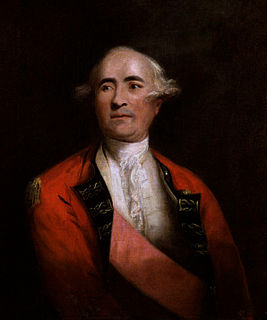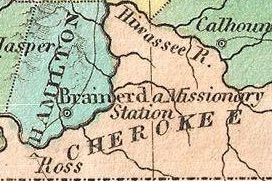The Cherokee are one of the indigenous people of the Southeastern Woodlands of the United States. Prior to the 18th century, they were concentrated in what is now southwestern North Carolina, southeastern Tennessee, and the tips of western South Carolina and northeastern Georgia.

Stand Watie, also known as Standhope Uwatie, Tawkertawker, and Isaac S. Watie, was a leader of the Cherokee Nation, and the only Native American to attain a general's rank in the Confederate States Army during the American Civil War. He commanded the Confederate Indian cavalry of the Army of the Trans-Mississippi, made up mostly of Cherokee, Muskogee and Seminole, and was the final Confederate general in the field to cease hostilities at war's end.

Sir Frederick Haldimand, KB was a military officer best known for his service in the British Army in North America during the Seven Years' War and the American Revolutionary War. From 1778 to 1786, he served as Governor of the Province of Quebec, during which time he oversaw military operations against the northern frontiers in the war, and engaged in ultimately fruitless negotiations to establish the independent Vermont Republic as a new British province. His administration of Quebec was at times harsh, with the detention of numerous political dissidents and agitators.

John Luther Adams is an American composer whose music is inspired by nature, especially the landscapes of Alaska, where he lived from 1978 to 2014. His orchestral work Become Ocean was awarded the 2014 Pulitzer Prize for Music.

The Catawba, also known as Issa, Essa or Iswä but most commonly Iswa, are a federally recognized tribe of Native Americans, known as the Catawba Indian Nation. They live in the Southeastern United States, on the Catawba River at the border of North Carolina, near the city of Rock Hill, South Carolina. They were once considered one of the most powerful Southeastern Siouan-speaking tribes in the Carolina Piedmont, as well as one of the most powerful tribes in the South as a whole.

The Lumbee Tribe of North Carolina is a state-recognized tribe numbering approximately 55,000 enrolled members, most of them living primarily in Robeson, Hoke, Cumberland and Scotland counties. The Lumbee Tribe is the largest state tribe in North Carolina, the largest state tribe east of the Mississippi River, and the ninth largest non-federally recognized tribe in the United States. The Lumbee take their name from the Lumbee River which winds its way through Robeson County. Pembroke, North Carolina is the economic, cultural and political center of the tribe. The Lumbee Tribe was recognized as a Native American tribe by the United States Congress in 1956, under conditions that it agreed to at the time, which did not allow them to have benefits available to other federally recognized tribes. According to the 2000 United States Census report, 89% of the population of the town of Pembroke, North Carolina, identify as Lumbee; 40% of Robeson County's population identify as Lumbee.

Oneota is a designation archaeologists use to refer to a cultural complex that existed in the eastern plains and Great Lakes area of what is now occupied by the United States from around AD 900 to around 1650 or 1700. Based on classification defined in Gordon Willey and Philip Phillips' 1958 book Method and Theory in American Archaeology, the Oneota culture belongs to formative stage. The culture is believed to have transitioned into various Siouan cultures of the protohistoric and historic times, such as the Ioway. A long-accepted ancestry to the Ho-chunk has yet to be conclusively demonstrated.

Eli David Marienthal is an American actor.

Lewis Downing, also known by his Cherokee name ᎷᏫ ᏌᏩᎾᏍᎩ ("Lewie-za-wau-na-skie") served as Chief of the Cherokee Nation from 1867 to 1872. After the death of John Ross, he was a compromise candidate who was elected to a full term as Principal Chief. Downing worked to heal divisions in the tribe following removal to the Indian Territory and the American Civil War. He was elected to a second term in 1871, but died in 1872, after a two-week battle with pneumonia. The Cherokee Council chose William P. Ross as his successor.
Waccamaw Siouan Indians are one of eight state-recognized Native American tribal nations in North Carolina; they are also known as the "People of the Fallen Star". Historically Siouan-speaking, they are located predominantly in the southeastern North Carolina counties of Bladen and Columbus. They adopted this name in 1948, when their congressional representative introduced a bill for federal recognition.

The Croatan are a small Native American group living in the coastal areas of what is now North Carolina. They may have been a branch of the larger Roanoke people or allied with them. The Croatan people of North Carolina who exist today live in Cumberland, Sampson, and Harnett counties predominantly.

Sir James Clark Ross was a British Royal Navy officer and explorer known for his exploration of the Arctic with Sir William Parry and his uncle, Sir John Ross, and in particular, his own Antarctic expedition from 1839 to 1843.
Thomas Warren Ross Sr. is an American public official who served as the president of the University of North Carolina system from 2011 to 2016. He succeeded Erskine Bowles on January 1, 2011. Formerly, he was president of Davidson College, a private North Carolina liberal arts college from August 1, 2007 to January 1, 2011.

Floyd Bixler McKissick Jr. is an American attorney and Democratic member of the North Carolina Senate. He was appointed to the Senate by Governor Mike Easley on April 18, 2007 to replace the late Jeanne Hopkins Lucas and was later elected and re-elected in his own right. In 2011, he became Deputy Minority Leader in the Senate and chairman of the North Carolina Legislative Black Caucus.

Town Creek Indian Mound is a prehistoric Native American archaeological site located near present-day Mount Gilead, Montgomery County, North Carolina, in the United States. The site, whose main features are a platform mound with a surrounding village and wooden defensive palisade, was built by the Pee Dee, a South Appalachian Mississippian culture people that developed in the region as early as 980 CE. They thrived in the Pee Dee River region of North and South Carolina during the Pre-Columbian era. The Town Creek site was an important ceremonial site occupied from about 1150—1400 CE. It was abandoned for unknown reasons. It is the only ceremonial mound and village center of that culture located within North Carolina.

Carolina Algonquian is an Algonquian language of the Eastern Algonquian subgroup formerly spoken in North Carolina, United States. Carolina Algonquian language was formerly spoken by Secotan, Chowanoke and Weapemeoc peoples.
The Cherokee in the American Civil War were active in the Trans-Mississippi and Western Theaters. In the east, Confederate Cherokees led by William Holland Thomas hindered Union forces trying to use the Appalachian mountain passes of western North Carolina and eastern Tennessee. Out west, Confederate Cherokee Stand Watie led primarily Native Confederate forces in the Indian Territory, in what is now the state of Oklahoma. The Cherokee partnered with the Confederacy in order to get funds, as well as ultimately full recognition as a sovereign, independent state.

Cherokee history is the written and oral lore, traditions, and historical record maintained by the living Cherokee people and their ancestors. The Cherokee people are those currently enrolled in one of the three federally recognized Cherokee tribes: The Eastern Band of Cherokee Indians, The Cherokee Nation, and The United Keetoowah Band of Cherokee Indians, who live predominantly in North Carolina and Oklahoma. The Cherokee people have extensive written records, including detailed genealogical records, preserved in the Cherokee language, the Cherokee syllabary, and in the English language.
Professor Dinesh Manocha is an Indian computer scientist, the Phi Delta Theta/Matthew Mason Distinguished Professor of Computer Science at University of Maryland College Park, formerly University of North Carolina at Chapel Hill. His research interests are in scientific computation, robotics, and 3D computer graphics.

Cherokee removal, part of the Trail of Tears, refers to the forced relocation between 1836 and 1839 of the Cherokee Nation and their roughly 1,600 black slaves from their lands in Georgia, South Carolina, North Carolina, Tennessee, Texas, and Alabama to the Indian Territory in the then Western United States, and the resultant deaths along the way and at the end of the movement of an estimated 4,000 Cherokee.
















